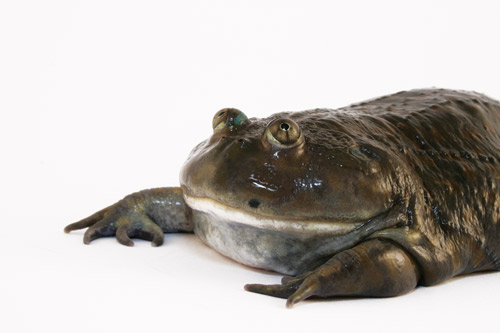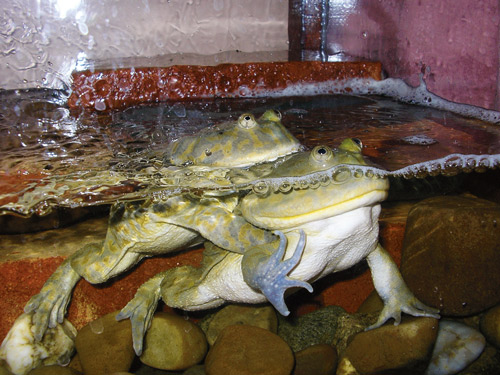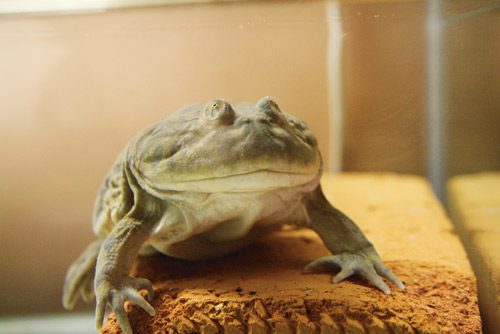Care for the hefty, large-mouthed Budgett’s frog.
Budgett’s frogs (Lepidobatrachus laevis), sometimes known as hippo frogs, are becoming increasingly popular pets. They have also been called Freddy Krueger frogs for their long fingers and aggressive nature. These frogs live for 15 to 20 years, and adults grow to be between 31⁄2 and 5 inches long, with exceptional specimens reaching 6 inches.
The somewhat-comical appearance of these large-bodied, big-mouthed frogs makes them attractive to many hobbyists. However, even today with the internet, there is still little information to be found on their captive-care requirements.
Easy to Distinguish
First described by its namesake John Samuel Budgett in 1899, the Budgett’s frog originates from the Gran Chaco. This relatively dry region of South America stretches from the south-eastern corner of Bolivia into western Paraguay and southward into Argentina as far as Santa Fe.
Budgett’s frogs share many similarities with others in the Ceratophryinae family, which includes two other species of Lepidobatrachus and the closely related horned frogs (Ceratophrys and Chacophrys). A loose, blue-gray vocal sac and nuptial pads, which develop during the breeding season, can distinguish adult males, as can the piercing shriek they make to advertise their presence to any potential mates in the area.
During the wet season, these frogs are sit-and-wait predators found feeding and breeding in temporary pools formed by heavy rains. Their large, flattened, gray-colored bodies are marked with irregular olive spots that become a more apparent reddish-brown color after dark. Their undersides are pale cream to white in coloration and unmarked. Their limbs are short and their hind feet webbed; their eyes are positioned on top of the head, allowing them to rest in shallow water with just their eyes protruding above the surface, waiting for unsuspecting prey to pass by. Younger specimens have a green coloration that surrounds the eye and extends down the back as additional camouflage. This usually fades away in adults but is kept by some.
As the winter nears and the pools dry up, Budgett’s use their hard, metatarsal tubercle spade to burrow into the mud, where they avoid desiccation during the dry months by encasing themselves in multiple layers of dry skin. They remain cocooned like this until the warm rains return, allowing them to come back to the surface to feed and breed once again.

When threatened by a predator, the Budgett’s frog will raise up on its legs and try to look as large as possible. It may also lunge for the perceived threat, make noises and bite.
Budgett’s Basics
Despite being so large, Budgett’s frogs do not require huge enclosures. This is a big advantage when maintaining more than one of these frogs, as they should ideally be kept separately to avoid potential cannibalism. Juveniles are especially cannibalistic and won’t hesitate to eat tankmates. Adults show less of a tendency to cannibalize, and adult animals of similar size may be kept together successfully if well fed. However, the risk is always present.
Usually, the Budgett’s frogs found in pet stores are juveniles, measuring approximately 11⁄2 to 21⁄2 inches long. At this size, they can be maintained in enclosures measuring 12 inches long, 10 inches wide and 10 inches tall, with a water depth of 2 to 3 inches. All water must be dechlorinated before use. An average-sized adult can be happily maintained in a glass aquarium measuring 24 inches long, 12 inches wide and 15 inches tall, with a water depth of 6 to 9 inches. Contrary to popular myth, these frogs are strong swimmers, and water of up to 12 inches deep will be no problem for an adult.
Frogs kept in cool water will feed poorly and are more likely to develop illnesses. Ideally, a temperature of 77 to 82 degrees Fahrenheit should be maintained using an aquarium heater with built-in thermostat. The frogs can easily dislodge heaters from their mountings while swimming and digging. To avoid this, choose a heater with an automatic cut-out in case it is accidentally moved above the water line.
Pay special attention to providing clean water. Filtration is advised, but it should cause little water movement and minimal disturbance to the animals. Air-powered box filters set to bubble gently are a good choice for young animals, but for adults an internal or external power filter with the outlet diffused by a spray bar is required. Budgett’s frogs produce large amounts of waste. The better the filtration system you have in place, the less maintenance will be required, and water changes can be kept down to a minimum.
Artificial lighting is not strictly necessary, but it will help give your frog a defined day and night cycle. Ultraviolet or other special lighting is not required, so a low-wattage, fluorescent tube designed for freshwater aquaria and set on a 12-hour cycle will do nicely. Providing a light will also help to keep any plants alive.
I do not use substrates such as gravel or sand, because ingestion is common and having no substrate also aids in cleaning. Décor in the form of rocks, driftwood, terracotta pots and plastic pipes should be arranged to provide hiding places and terraces in the aquarium, so the frog can choose a suitable resting position at its preferred water depth. Any décor used should be too large for the frogs to swallow. Many keepers are surprised by how a large pebble or aquarium ornament can be swallowed whole, resulting in a rather costly trip to the veterinarian. Hardy, aquatic plants, such as Amazon sword and java fern, along with cuttings of hydroponically grown devil’s ivy, can also be used to further decorate the aquarium. A platform allowing the frog to completely leave the water should also be provided.
Big Eaters
Young Budgett’s should be offered food daily. Their diet consists of a mixture of live insects, including earthworms, crickets, roaches and wax moth caterpillars. Small, live-bearing fish may also be fed from time to time to provide additional variety. Young frogs should be allowed to consume as much as they will take in a sitting, this may be several invertebrates or in the case of larger prey may only be a single item.
Adults can be fed less often, only requiring a good meal two to three times a week. Adult Budgett’s will often feed whenever given the chance, and as such, it’s easy for them to overfeed. A healthy adult should be longer than it is wide; for individuals prone to overfeeding, you should offer food less often. Suitable foods include large Lumbricus worms, locusts, roaches and de-shelled African land snails. Fishy foods, such as prawns, sardines and whitebait, may be offered for variety. Fish must be warmed to destroy the thiaminase enzyme and allowed to cool before feeding.
Budgett’s frogs will eat both in and out of the water; place live foods on the land platform or drop them onto the water’s surface. Inanimate prey may be offered by tongs. Be careful when putting food into the enclosure, as these frogs are aggressive feeders and will often launch themselves out of the water to catch their approaching prey. Due to a row of very sharp maxillary teeth running along the upper jaw and a pair of large odontoid projections in the center of the lower jaw, a bite will hurt and will often draw blood.
Pre-killed rodents may be fed from time to time, but frogs fed large numbers of rodents tend to be sluggish and lethargic. If feeding rodents, offer a hairless strain of mouse and wait for the frogs to defecate before feeding again — this could be 10 to 14 days after a large meal. I advise hairless mice over regular mice, because the undigested fur is a nightmare to clean out of the aquarium.
Usually a couple of days after feeding, the frogs will defecate. When you notice waste in the water, siphon it out immediately and perform a partial water change.
Young frogs grow rapidly and have the potential to reach adult size in as little as six to nine months. Due to this rapid growth, they require a good supply of calcium and vitamin D3 in their diet to ensure healthy bone development. Ideally, a high-quality calcium and multivitamin supplement should be dusted over food at every other meal. You may cut down the frequency of supplementation as they mature. Adults maintained on a varied diet should only need supplements on one feeding every other week.

Except for during breeding season, these frogs should be kept separately, as this species does have a tendency to be cannibalistic.
Winter Rest
Although some Budgett’s frog owners disagree, I believe it is important to allow these frogs to aestivate each year as they would in the wild. Budgett’s frogs that are not allowed to aestivate yearly are typically more prone to developing respiratory problems. However, be warned: Aestivation comes with its own dangers, and only frogs in the best possible health should be subjected to the stresses involved.
Time the frogs’ aestivation period to coincide with winter in your area. This makes it easier to provide the cooler temperatures required. That said, quite often the frogs themselves will tell you when they are ready; a loss of appetite and spending more time out of the water are common signs.
To prepare the frogs for aestivation, feed them heavily for a two- to four-week period to ensure they carry sufficient fat reserves to last the winter. Then stop feeding them to ensure their guts are completely empty before entering aestivation, this should take approximately two weeks but will depend on the prey items that were offered in prior feedings. During aestivation, a frog’s metabolism and digestive system will slow down greatly, and any food left in the gut could potentially rot, ultimately causing death.
Slowly lower the water in the aquarium over a period of two to three weeks until the level has reached 1 to 2 inches. Then add substrate to one end of the aquarium where the frog can dig. My preference is for a coco-fiber-based substrate, as I find it easier to maintain the all-important moisture levels during the aestivation. Other suitable substrates include sedge, peat and sphagnum moss or a blend combining any of the above. Continue to lower the water level until all of the water has been removed from the aquarium. At this point, fill the tank with slightly moistened substrate lightly compacted to a depth of 12 inches, and gradually lower the temperature to the high 60s to low 70s. With this relatively dry environment and lower temperature, the frogs should begin to burrow. If they remain at the surface, don’t panic just yet, as some individuals won’t start to burrow until the temperatures are reduced further. Provide a shallow bowl of water just large enough for the frogs to soak in, and keep it clean and full at all times. Choose a heavy bowl that will not be tipped over when the frog burrows into the substrate.
Continue to gradually lower the temperature until all frogs have burrowed fully; most Budgett’s will have burrowed by the time the temperature reaches 59 degrees. If by this time a frog still refuses to burrow, transfer it back to an aquarium and return it to normal conditions until it shows the aforementioned signs of wanting to aestivate and then try again.
Once completely buried, you can slowly let the substrate dry further. Gently turning the substrate from time to time, while being careful not to disturb the frogs, will help with the drying process. As the moisture content of the substrate lowers, the outer layers of the frogs’ skin will begin to dry and harden, and they will cocoon themselves inside these skin layers to prevent water loss.
You must check on each Budgett’s frog regularly, gently uncovering them slightly and checking for signs of life, because any frogs that have not cocooned themselves properly may quickly desiccate. Be careful to avoid sudden temperature fluctuations, and continue to provide a shallow bowl of fresh water in case the frogs wake prematurely. Frogs that do will surface early and will require rehydrating and warming. The aestivation period can last from several weeks for juveniles to several months for older individuals.
The Awakening
Once you feel sufficient time has passed, and you are ready to wake your Budgett’s frog from its slumber, raise the temperature by 3 to 4 degrees every three to four days. Whilst warming the frogs back up, you should slowly start to rehydrate the substrate in the enclosure by adding warm water; do this gradually to mimic the water from the onset of summer rains filtering down into the soil.
As the frogs awaken, they will be unable to move until the hard, dry skin cocoon has begun to soften, allowing them to shed it completely and make their way to the surface. If the frogs do not surface of their own accord, they should be dug up and moved to a small tank containing an inch of warm water. Spray them gently at regular intervals to aid with the rehydration and shedding. At this time, frogs will shed and urinate profusely, and the water will require changing as often as every couple of hours.
For the first week, keep the frogs in shallow water, and after a few days you may start to offer food. When you offer it depends on how quickly the frog has surfaced and at what temperature. Begin by offering only small amounts of live foods. Most frogs will be reluctant to feed at first, but as you gradually flood the tank and return everything back to normal, their appetite will return.
After following the above guidelines for aestivation, you may notice male Budgett’s coming into breeding condition. The loose, dark skin of the throat will drop, and nuptial pads will develop on the inside of the first digit. Males will choose a position in the aquarium where they can stand with their head just above the surface of the water to emit their loud squawking call. Females usually take a little more conditioning to prepare them for breeding. If you are lucky enough to achieve a successful breeding, be prepared for lots of work rearing the hundreds of carnivorous and cannibalistic tadpoles and resulting froglets.

Provide décor in the form of rocks, driftwood, terracotta pots and plastic pipes to offer the frog hiding places and terraces, so it can choose a suitable resting position at its preferred water depth. .
Outstanding and Odd
The Budgett’s frog is an outstanding amphibian. Its wide face, odd proportions and comical appearance, coupled with its aggressive nature and big appetite, make for a fun and fascinating pet. In recent years, these frogs have become more readily available from commercial breeders thanks to the use of hormones. With the increased availability has come a drop in price, bringing them inline with the price range of other hefty frogs.
Big Show
In the wild, Budgett’s frogs will prey largely on other frogs that share the same temporary breeding pools, as well as large insects found at the water’s edge.
If confronted by a predator while in water, they quickly burrow down into the mud and silt, but if confronted by a predator while on land, they put on a show of aggression, inflating themselves and rising up on all four limbs to make themselves look as large as possible. If this is not enough to deter the approaching predator, they will lunge forward, mouth agape, biting and squawking in an attempt to drive it away.
I do not recommend Budgett’s frogs to the novice keeper. There is still a lot to discover about the optimal care for these hefty beasts, but having firsthand experience of aestivating other species, such as the closely related and somewhat hardier horned frogs (Ceratophrys), will be a big advantage to those taking up the challenge. For those with a little experience, and more important, the time and patience to properly research and learn about the natural cycles that these frogs face in the wild, the task of mastering their somewhat complex care requirements can make a very rewarding project.


